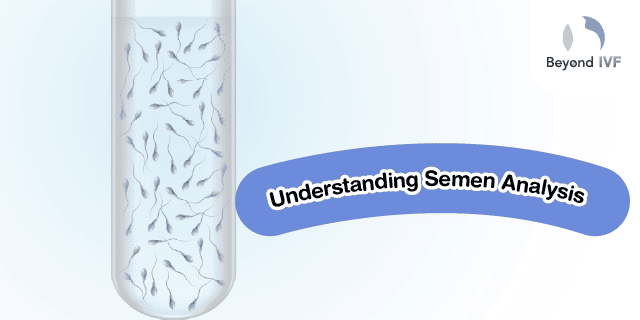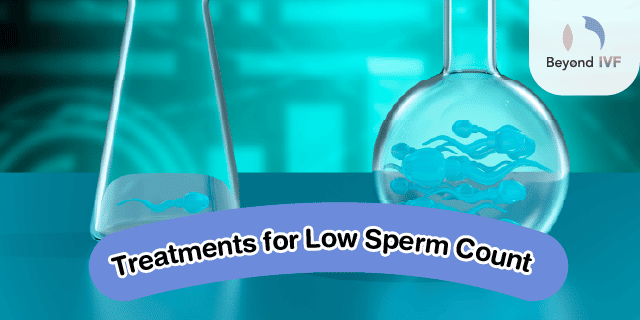
Sometimes infertility is caused by the male partner. That is why a semen analysis is important to assess the quality and number of sperm in the semen and shouldn’t be overlooked. Read on to find out more about how it’s done, when it should be done, and how to interpret results.
What is Semen?

Semen is a thick liquid that is released from the penis during orgasm (ejaculation). Its function is reproduction, with sperm making up 10% of semen. It is also made up of enzymes, Vitamin C, calcium, protein, sodium, zinc, and fructose.
These nutrients help sperm organize and provides energy for sperm to travel to fertilize the egg after sexual intercourse. Semen contains no less than 15 million sperm per milliliter of semen. The viscosity of semen allows sperm to be released slowly and travel in an organized manner into the uterus.
Understanding Semen Analysis

Semen analysis is an assessment of the number and motility of sperm and detects any abnormalities to find the cause of infertility in men. Semen is collected in a sterile container prepared by the laboratory.
Benefits of Semen Analysis
The benefit of semen analysis is to assess the quality of sperm to see if it is the cause of infertility, including the following factors:
- Issues with sperm count may be related to the narrowing or obstruction of the vas deferens, problems with the testicles producing sperm or producing fewer sperm than normal.
- Sperm do not move normally, preventing them from traveling through the cervix to meet the egg in the fallopian tube.
- Sperm is shaped abnormally, making fertilization impossible.
Who Needs A Semen Analysis?
Semen analysis is recommended when a couple is experiencing infertility. However, some people may consider undergoing a semen analysis earlier than that for the following reasons:
- Health condition or behavior that affects the quality of sperm, such as smoking, liver disease, kidney disease, diseases of the immune system, or a history of sexually transmitted infection.
- Semen quality deteriorates only slightly after 30, but significantly impacts the ability to conceive after 40.
- Female partner is over 37 and would like information from semen analysis for family planning.
Preparation for Semen Analysis

- Avoid sexual intercourse and ejaculation for 5-7 days before the semen analysis.
- Wash your hands before semen collection.
- Collect semen yourself in the sterile container provided.
- After collecting semen, close the lid of the container tightly and submit it to the laboratory within one hour.
- It is not recommended that semen is collected in condom as the lubricant in the condom can destroy sperm.
Semen Analysis Procedure
1. Macroscopic Examination
- Semen volume: 1.5 ml or more.
- pH: 7.2 or more (alkaline).
- Viscosity: normal semen, when dropped with a pipette, should be no longer than 2 cm.
- Liquefaction: semen should dissolve in no more than 1 hour.
2. Microscopic Examination
- Viability: 58% or more live sperm.
- Sperm concentration: 15 million cells/ml or more.
- Motility: 40% or more mobile.
- Morphology: 4% or more normal forms.
- WBC: no more than 1 million white blood cells/ml; too many white blood cells indicate infection.
- RBC: no more than 1 million red blood cells/ml; too many red blood cells indicate infection or injury.
Semen Analysis Test Results

Normal Results
- Semen volume: the normal amount of semen that a person ejaculates should be more than 1.5 ml; if the amount is lesser than normal, there may be a narrowing or blockage of the vas deferens or a problem with the reproductive system.
- pH: semen is alkaline and the pH should be more than 7.2; a pH of less than 7 with lower than normal semen volume may indicate an obstruction of the vas deferens.
- Sperm count: the number of sperm is divided into 2 categories—the total number of sperm and the number of sperm in 1 ml of semen, with normal values being more than 39 million for total sperm number and more than 15 million for sperm concentration (in 1 ml of semen).
- Sperm motility: some sperm will move, some not as well, and others not at all; there are two categories when assessing motility—percentage of sperm that moves well and percentage of all sperm that moves (well and not so well), with normal values being more than 32% for progressive motility and more than 40% for total motility.
- Sperm morphology: the shape of sperm is assessed, with normal value being more than 4% of sperm have normal forms.
- Vitality: with the sperm that is not moving, at least 58% should be alive.
Abnormal Results
- The normal color of semen is white/gray; if it is green, yellow, or has some red mixed in, this indicates a problem that requires further examination to rule out infection, prostate cancer, jaundice, et.
- Semen volume is less than 1.5 ml when a person ejaculates.
- Normally semen is viscous when first ejaculated and begins to dissolve over 15-30 minutes and will become more liquid. If semen is still viscous after 30 minutes or clumps together, it may indicate a problem.
Treatments for Low Sperm Count

- Surgery may be an option to treat varicocele in the scrotum, to repair the vas deferens, or to reverse a vasectomy. Semen can also be collected directly from the testicles as needed.
- Any infection of the reproductive system should be treated with antibiotics, but this may not resolve infertility.
- Treating any sexual problems can help with reproduction, such as erectile dysfunction or premature ejaculation.
- Your doctor may recommend hormone replacement therapy or the use of other medication in case of infertility caused by hormonal imbalance or the body’s inability to use the hormones.
- Technology can help with conception, whether collecting sperm through normal semen collection or surgically from the testicles or using a sperm donor, depending on the circumstances and the needs of the family. Collected sperm can then be used to fertilize egg using IVF or ICSI.
Costs of Semen Analysis
The cost of semen analysis at Beyond IVF is 1,500 baht and will assess semen volume, sperm count, sperm concentration, motility, morphology, and vitality, as well as look at red and white blood cells in the semen. Results take just 1-2 hours and results will be interpreted by a specialist in every case.
Semen Analysis at BeyondIVF

At Beyond IVF our fertility specialist provides explanations and recommendations after careful evaluation. All test results should be interpreted by a medical professional who specializes in the treatment of infertility, which goes beyond a regular obstetrician-gynecologist. Only a fertility specialist can provide the appropriate information and recommendations to achieve a successful pregnancy.
At Beyond IVF our sperm collection rooms are disinfected after every client, and we ensure cleanliness and safety. Our team of scientists and nurses are well trained and experienced in this field.
To Learn More about Semen Analysis
Since infertility can be caused by either partner, a semen analysis is an important part of the assessment for the cause of infertility. The analysis can also reveal any infection or contamination by blood that can indicate more serious conditions that require immediate treatment. A semen analysis should always include a discussion with a doctor to understand results and plan the appropriate treatment based on each client.
For more information, please contact us via Line @beyondivf








